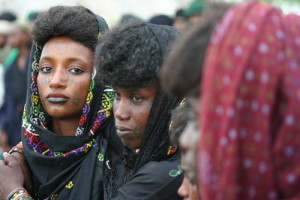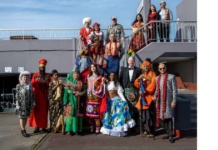Fula people or Fulani or Fulbe (Fula: Fulɓe; French: Peul; Hausa: Fulan; Portuguese: Fula; Wolof: Pël; Bambara: Fulaw) are the largest Migratory ethnic group in the world. They are an ethnic group spread over many countries, predominantly in West Africa and Northern parts of Central Africa, but also in Sudanese North Africa. Overall, the territory and range of where Fulani people can be found, is significantly larger than the United states and Western Europe in area. Being one of the most widely dispersed and culturally most diverse people of the African continent, Fulani culture comes in a myriad of different expressions in clothing, Music, and lifestyle. However, they are bound together by a common language and some basic elements of Fulbe culture, such as the “‘Pulaaku'” African countries where they are present include Mauritania, Ghana, Senegal, Guinea, the Gambia, Mali, Nigeria, Sierra Leone, Benin, Burkina Faso, Guinea Bissau, Cameroon, Côte d’Ivoire, Niger, Chad, Togo, Republic of the Congo, Democratic Republic of the Congo, South Sudan the Central African Republic, Liberia, and as far East as the Red sea in Sudan, Eritrea and Egypt. Some Fulani artefacts created by fulbe communities in Eritrea, are currently displayed in the British Museum collections, some of these artworks, include Calabash or Gourd vessels, intricately decorated in deep carvings of black, very similar to same sort of craft, made by their pastoral brethren from further West Fula people form a minority in every country they inhabit, except in Guinea where they are the largest ethnic group, representing some 40% of the population
The majority live in Middle Guinea, or the Fouta Djalon of Guinea, an area consisting of mountains and plateaus. They speak a Niger-Congo language called Futa Jalo (or Pulaar).
Along the plateaus of Fouta Djallon, there are grassy plains and fields of millet. Fulani herders settled in this region over 200 years ago and have since spread throughout western Africa. The Fula Jalon are a sub-group of this vast Fulani people group. They are semi-nomadic and raise crops as well as livestock. The high plateaus serve as part-time pastures for their herds.
The Fula Jalon of Guinea have also moved into southern Senegal and northern Sierra Leone, leaving the culture and heritage of this tribe in all three countries virtually identical. Today, the only differences are ones of terrain or climate.
The livelihood of the Fula Jalon is primarily based on farming and shepherding. Gathering forest produce, hunting, fishing, and trading are also part of their daily lives. Staple crops include millet, rice, and peanuts. Cattle herds, along with sheep and goats, are the primary livestock. The cattle are not the usual Fulani “humped” breed, but a native Fouta Djallon breed that is resistant to the disease-carrying tsetse fly.
Herding cattle is usually a male activity; however, the women milk and take care of the cattle. Women also care for the poultry and small livestock, as well as cultivate the gardens. Women often carry containers of milk and cheese to sell or trade in local markets.
Daughters remain with their mothers until they marry. However, as soon as a son reaches puberty, he leaves the family compound and lives alone in a nearby compound, usually with some cattle. This new compound becomes the home of the son and his future wife.
The first marriage of a man is usually arranged by the man’s father. A bride-service of helping the girl’s father with his livestock is performed by the man, who usually marries in his early twenties. Polygyny (the practice of having more than one wife) is practiced, up to the Muslim limit of four wives. There is one chief wife, however, who has authority over the other wives.
Children belong to “age-sets” until they marry. An age-set is grouped at three or four year intervals, with every child born in those years belonging to that set. The children in an age-set go to school together and may participate in community labor, or may help someone in their set with bride-service. Each age-set has a leader, a deputy, and a judge.
Although Fula Jalon villages are scattered, each village has a central court and a mosque. Houses belonging to the settled Fula Jalon are typically round with mud walls and thatched roofs. Each hut has an encircling verandah. The nomadic Fula Jalon live in open, beehive-shaped huts without walls or verandahs. Each hut is surrounded by a cattle corral. Each village has a headman who handles village affairs and answers to a paramount chief.
The Fula Jalon are almost completely Muslim, faithfully following the teachings of the Koran (Islam’s “holy book”). They believe that Allah is the only god and that Mohammed is his prophet. Islamic schools are also set up for the children in some of the villages.











Thank you for such an insightful article on the Fula Jalon. I’m from the U.S. and just found out through dna testing my grandmother is Fulani. I hope to visit my ancestral homeland. Thanks!
Comments are closed.